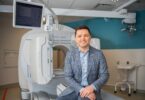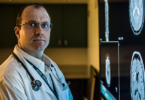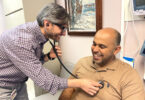“Brushing my teeth became a chore. I was losing my breath doing small, trivial activities,” says George Karkanis, who tested positive for COVID-19 at the end of 2020.
When George’s symptoms began, they were initially very mild. “After isolating myself for about a week, I started to feel worse. My muscles ached, I couldn’t concentrate on simple tasks, and I felt very winded after the slightest movement,” explains George.
Primarily dealing with the cognitive and physical symptoms associated with Long COVID, George worked virtually with clinicians at St. John’s Rehab to build his mental and physical strength. Through the St. John’s Rehab Outpatient Post-COVID Rehab Program, Sunnybrook patients who experience lingering or residual deficits from COVID-19 infection are enrolled in an active rehabilitation program to manage their recovery.
When patients who have been diagnosed with COVID-19 continue to experience symptoms, it becomes an issue of Long COVID. This is where a rehabilitation consult may be beneficial and can be conducted as early as 4 weeks after COVID-19 diagnosis.
“When we are presented with a patient that has continued symptoms, it’s important for us to work with them to figure out their rehab focus. It helps us organize their care plan and tap into additional supports, when needed,” explains Dr. Melody Nguyen, physiatrist in the division of physical medicine and rehabilitation. She adds, “It’s not just physiotherapy – we’re looking at the whole person.”
Current research emphasizes the importance of a personalized approach to rehab given the many areas of the body that can be impacted by the virus. Dr. Marina Wasilewski, a scientist at St. John’s Rehab recently published a scoping review evaluating the current research on rehabilitation for COVID-19. “We know a range of respiratory, physical, psychosocial, cognitive and cardiovascular complications can persist following COVID-19,” says Dr. Wasilewski. “Our review underscored the importance of individualized rehabilitation programs provided across the care continuum by an interdisciplinary team of professionals.
For George, the personalized goals he set for rehabilitation included activities that are often taken for granted such as remembering names, making his bed, and participating in light gardening. “They were simple activities that I wanted to be able to do again and my care team helped me along the way to build my endurance,” shares George.
Regaining functional independence through occupational therapy
Sarah Rockman is an occupational therapist and was on George’s care team. “I was looking to help George regain his functional independence at home, in the community and at his place of work,” says Sarah.
Patients with Long COVID have been reported to experience symptoms like brain fog or mental fatigue. “When it comes to long-term recovery, we want to make sure everyone has the necessary education and resources to get back to their pre-COVID functional ability,” explains Sarah. She adds, “Rehabilitation can be vital for this patient group.”
This meant focusing George’s treatment on some of the cognitive aspects of Long COVID. “George expressed some cognitive challenges, especially at work. He noted that he was having difficulty focusing on tasks, forgetting people’s names, and was mentally and physically exhausted after just a few hours of work,” explains Sarah.
In occupational therapy, Sarah worked with George on the importance of pacing and working with external aids to assist with scheduling and monitoring his activities. Over time, George was able to learn effective memory and energy conservation strategies that could be easily incorporated in his day-to-day activities at home and at work.
“We slowly and gradually increased George’s mental and physical endurance to work in larger chunks of time and re-adjusted his goals as needed. With this plan in place, George was able to return to work and noted improvements in his cognitive abilities,” shares Sarah.
COVID rehabilitation and virtual care
The St. John’s Rehab Outpatient Post-COVID Rehab Program uses a hybrid model of in-person and virtual appointments. For some patients, having treatment sessions in-person meant they could access equipment that may not be available at home. For others, virtual treatments were more appropriate. Depending on the patient, this model of care is adjusted to better serve the rehabilitation goals of each patient.
All of George’s appointments were conducted virtually. “Based on George’s needs and goals, we were able to provide treatment successfully via Zoom. We were able to implement the treatment and strategies he needed at a distance,” explains Sarah. She adds, “Virtual care is appropriate for some patients, and is always dependent on their needs and goals. Some patients might need a more hands-on approach which we are able to provide at St. John’s Rehab.”
“My experience with the program was amazing,” shares George. In addition to working with Sarah on building his cognitive strength, he worked with physiotherapist, Jean Yee, to build his physical strength.
He explains, “I was progressing pretty well but had a few bad days here and there. Jean was able to help me adjust my treatment plan to something that was better suited for me.” The skills that George learned with the experts at St. John’s Rehab benefitted him at the time of his treatment and still benefit him today.

George clears snow from the sidewalk at his home
George explains, “There’s not a lot of information about Long COVID right now, and at times, it felt like I was alone or that it was never ending. My care team was really supportive of my journey and if I stumbled or needed help, they were only an e-mail away.”
Rehabilitation experts can provide the patient with a connection to their community, especially during this significantly isolating time.
“There is a lot of anxiety attached to recovering from COVID-19. Seeing other people or going back to work can be some very real barriers for some patients and rehabilitation acknowledges those barriers,” explains Dr. Nguyen.
She stresses, “It’s so vital to recognize that if something doesn’t feel right, you can and should advocate for yourself. Get in touch with your family physician and see what kinds of resources or educational opportunities are available so you can get back to your usual day to day activities.”








